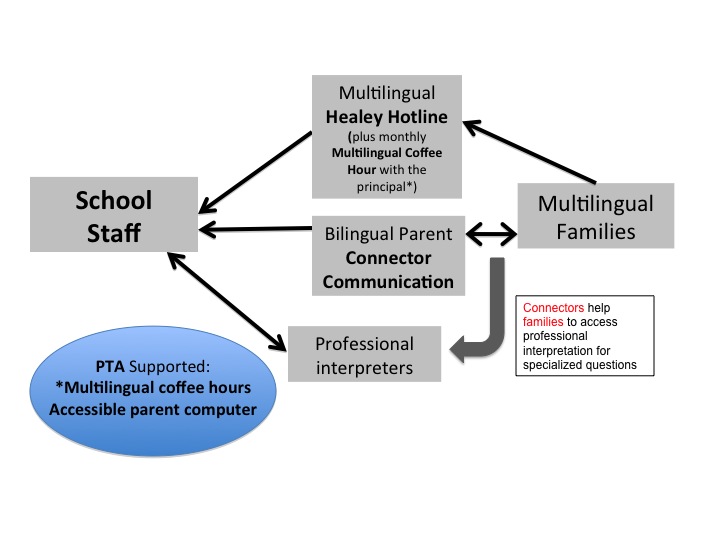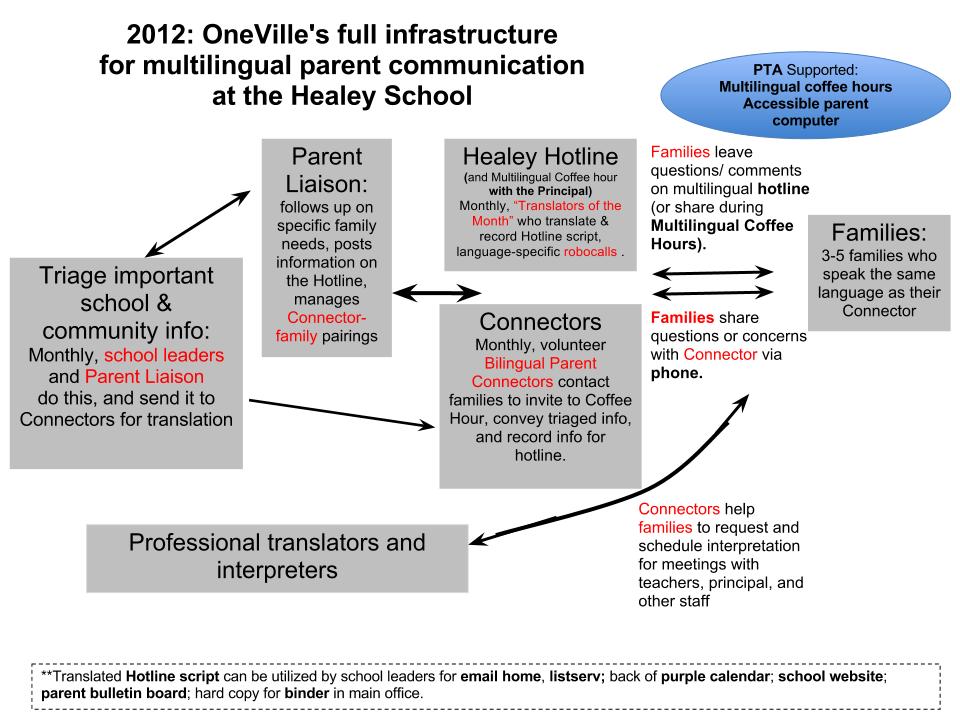Summary: Schoolwide toolkit/parent connector network
From Oneville Wiki
Written by Mica Pollock, Jedd Cohen, Tona Delmonico, Gina d'Haiti, and Ana Maria Nieto for the Parent Connector project, with input from parents across the Healey School (particularly Consuelo Perez, Lupe Ojeda, Sofia Perez, Maria Carvalho, Ivanete Calmon, Veronaise Chaiki, Will Thalheimer, Tracy and Dave Sullivan, Adriana Guereque, Maria Oliveira, Manoj Archarya, Claudia Ramos, and Michele Arroyo-Staggs).
Click here for the Overview and key findings on this project; click here for the Expanded story on this project.

What communication challenges did this project address?
Ensuring that everyone in a school can partner in student success requires overcoming structural barriers to communication between the school and families who share it. With parents, teachers, staff, and administrators at the K-8 Healey School in Somerville, we've been working toward a toolkit of tools and strategies for schoolwide communication that includes families across lines of language, income, background, literacy skills, and tech access/training. Over the course of three years, we met parents particularly committed to improving schoolwide communication and linked them in to lead the design effort.
In 2010-11 and 2011-12, we focused particularly on strategies for including immigrant parents in the loop of school information and input. We focused on creating the infrastructure of a "Parent Connector Network," in which bilingual volunteer parents ("Connectors") help get information to and from immigrant parents who speak their language. Parents and staff have been figuring out how a combination of face-to-face communication strategies and inexpensive technology can help ensure that all parents in a multilingual and mixed-income school can access important school information and share ideas with other parents and school staff.
Basic Parent Connector Network Model (see the bottom of this Summary page for our full set of final "components"):

Watch a video of Parent Connectors describing their experience creating the Parent Connector Network:
<videoflash type="youtube>xMtoxUyPSU0</videoflash>
Why is it important to improve communications?
What we found:
- ¡Aha! Along with strong intentions to include all families, diverse schools need systems -- infrastructure -- for getting information to everyone and input from everyone. If structures don’t exist to get info out and input in, information just doesn’t get distributed, translated, or shared despite good intentions. And parent-school partnerships that could happen, don’t.
- ¡Aha! Overall, we’ve learned that committed and diverse parents can be expert innovators of communication infrastructure for including all parents because they have a full understanding of communication barriers.
- ¡Aha! In a multilingual school and district in particular, improving communications -- and strengthening relationships between families and educators -- requires creating a standing infrastructure for effectively tapping a key local resource: bilingualism.
- ¡Aha! Building relationships -- so diverse parents feel comfortable sharing information and ideas -- is as important as ensuring access to information and ideas.
How do Parent Connectors work? How would it be implemented?
- The core of the Connector Network model is 2-way home-school communication facilitated by bilingual parent Connectors (with the coordination help of a school-based parent liaison or staff). If willing, bilingual parents ("Connectors") might volunteer time to build relationships with immigrant families who speak their language and help get information to and from them. Click here to see how we got to this point.
- Connectors can call 3-5 other families once a month to share key information from the principal/school and to ask questions about any issues parents are facing. Connectors may accompany their families to PTA conferences and/or help them to request interpretation and set up meetings with teachers. We also learned that face-to-face, parent-parent relationship-building in school social events, like our Multilingual Coffee Hour, is key even while calls home can help with initial connections and information access. Also, we're now learning that Connectors may connect perhaps most effectively to same-language parents who share their child's own grade.
- Translating material efficiently requires organization -- a system for triaging and translating school information for families. While translating official documents will always require professional translation, volunteer or stipended “translator of the month” Connectors can help paid staff prioritize and translate school information. Bilingual volunteers can also help school staff share such information out via a multilingual schoolwide parent listserv and strategic use of school robocalls.
- Translated public information and parent FAQs can also go onto a free multilingual hotline to reach people who rely more on phones than the internet (contact us if you want to create a hotline!).
- Because parent volunteer availability changes, the Network needs to recruit Parent Connectors each year and on an ongoing basis.
- Connectors can become constant innovators of communication infrastructure. Healey Connectors in this project constantly asked, "How can we reach families more effectively?" In the spring of 2012, we started experimenting with: Connectors providing informal interpretation for parents trying to connect to teachers and staff, when families drop off their kids early in the morning or pick them up in the afternoon; creating a translated public list of services that all parents are entitled to regardless of documentation status, so that all parents and teachers are informed of what's available; and hosting multilingual parent coffee hours around town in addition to inside the school. Parents also have suggested that hosting multilingual school-related events where parents already gather (e.g., church) may be just as effective as trying to bring parents to school-based events.
- In sum, face-to-face elements of the Connector infrastructure by spring 2012 included the following: a multilingual coffee hour, where parents can meet each other and ask questions of the principal; Connectors who link parents seeking translation, to staff before and after school; a process for Connectors to triage and then, translate key school information on to a school hotline and other channels; and social events where Connectors meet other parents.
- Technological elements of the Connector infrastructure include phone calls home, a hotline and a strategic use of robocalls for getting information to all families, a secure online spreadsheet of parent contact info for Connectors, a Googledoc of basic contact info/citywide parent services info all Connectors need to know https://docs.google.com/document/d/15eF7hZP5DUCwl92WTYcOrElUWDICTdx69WjDgs8UfOI/edit, and a fall parent communication form (see File:Healey School Communications Sign-Up Form 2011.pdf) to help parents sign up to get a Connector and allow parents to record their preferences for contact. We’ve also been exploring computer training of parents.
- Here's a full diagram of the infrastructure model we created and tested:
- (Here's a link to the story of how we got to the point of testing this “infrastructure” for multilingual translation and interpretation.)
How do you know if your school could improve communication?
Questions to ask about the current system in your school:
- ➢ Can everyone who needs to get and share important school information, get and share it? Do parents know who to talk to when they need information?
- ➢ Where do you put school information so that everyone in the school can see it?
- ➢ How do you share parent ideas around the school?
- ➢ What system do you have for translation and interpretation, in particular?
- ➢ How can you tap local bilingualism, either paying local people to translate material or organizing bilingual volunteers to pitch in on translation and interpretation in a way that doesn't take too much of their time?
- ➢ How can you build on and strengthen parent-parent relationships to pull all parents into school events and conversation?
- ➢ What tech training do parents need in order to get information? How could you help all parents get this training?
- ➢ Which efforts at parent information should be a task for school staff rather than volunteers?
The Next Layer: Connecting to Folks Doing Similar Work in Other Communities.
We'd love to spark a lively exchange between people working on similar things.
Want to talk further?
Are you working on improving communications in your own school or community?
Contact point people for the Parent Connector Network directly at:
Jedd Cohen (jic378@mail.harvard.edu); Tona DelMonico (tona_d@comcast.net) Ana Maria Nieto (amn956@mail.harvard.edu); questions on our first 2 years can go to Mica Pollock (mica.pollock@gmail.com)
Click here for the Overview and key findings on this project; click here for the Expanded story on this project.
